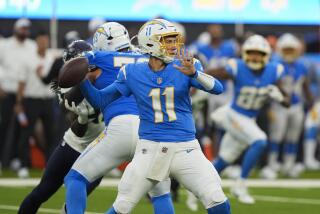45-Man Rosters Cause Problems for Coaches
- Share via
SAN FRANCISCO — Ecomonics can be cruel around cutdown time at National Football League training camps.
Talented youngsters, many of whom have been stars at every level of football they have played, are told they just are not good enough to continue. Many veteran players, who have given years of effort, are told they are just too old.
It has always been a harsh numbers game, but in 1985 the game grew even colder when NFL owners decided to reduce the size of the team rosters from 49 to 45 players to save money.
However, the NFL Players Assn. says the teams really do not save that much in cutting down the rosters.
“The study we did last year showed that with a 49-man roster teams on an average paid 58 players during the season,” said NFLPA spokesman Frank Woschitz. “At 45, they paid 56. The saving is not that significant since the two players would probably be rather low paid rookies.”
This year, with a decision by the U.S. Football League to release its remaining players from their contracts, the player market has become flooded with talented athletes. Because of the increased talent pool, Dallas Cowboys President Tex Schram decided to put forward a proposal to once again raise the roster limit to 49.
On Aug. 13, that proposal was soundly defeated.
“It was a feeling of not wanting to change horses in mainstream,” said NFL Commissioner Pete Rozelle after the owners’ vote. “We’ve already started training camp with a 45-player limit and we don’t want to change the rules.”
Rozelle’a statement would indicate there is a chance for a rule change in the offseason. Bill Walsh, San Francisco 49ers head coach and president, doesn’t think that is a possibility.
“We prefer a larger roster, but I’m afraid there is too solid of a group opposing any further expenses,” he said. “I think there will likely be 6 or 8 or 10 votes against increasing the roster size no matter when the vote is taken.”
The fact that it appears the 45-man roster is here to stay isn’t making it any easier for coaches to accept.
“Beacuse of the way the game is played today, I think the 45-man roster is unrealistic,” said Los Angeles Raiders Coach Tom Flores. “How do you keep the young players to develop your squad for the future? How do keep the people who excel on your special teams?”
Dallas Coach Tom Landry agrees.
“The thing the 45-man roster does is it doesn’t allow you to delevop your young players,” he said. “We just don’t have anywhere we can send a young player to develop right now. With 49 men on the roster, you have some guys who will be allowed to come along slowly.”
Flores also says the reduced roster size has added to the guessing game coaches play from week to week during the regular season.
“Sometimes you get people banged up that aren’t going to be back until later in the week, if then,” he said. “These are nightmares for a coach. You don’t know if you should bring in other people to take their place or wait and see if they will recover.”
Injuries, especially if they occurred at one position, can have a devastating effect on a team with the 45-man roster.
“The way the game is play right now it is so long and so tough. You play 20 games and it is going to take its toll,” Landry said. “If you get 2 or 3 guys hurt at one position -- you are about out of business.”
The roster size also has changed the way coaches look at their lineup. Players that were kept on the roster during the NFL’s years of specialization are now out of a job.
“I feel most teams will probably have to limit their special teams,” said Cleveland Browns Coach Marty Schottenheimer. “In other words, a guy who might have been kept strictly for a kick and punt coverage might now be out of a job.”
More to Read
Go beyond the scoreboard
Get the latest on L.A.'s teams in the daily Sports Report newsletter.
You may occasionally receive promotional content from the Los Angeles Times.










